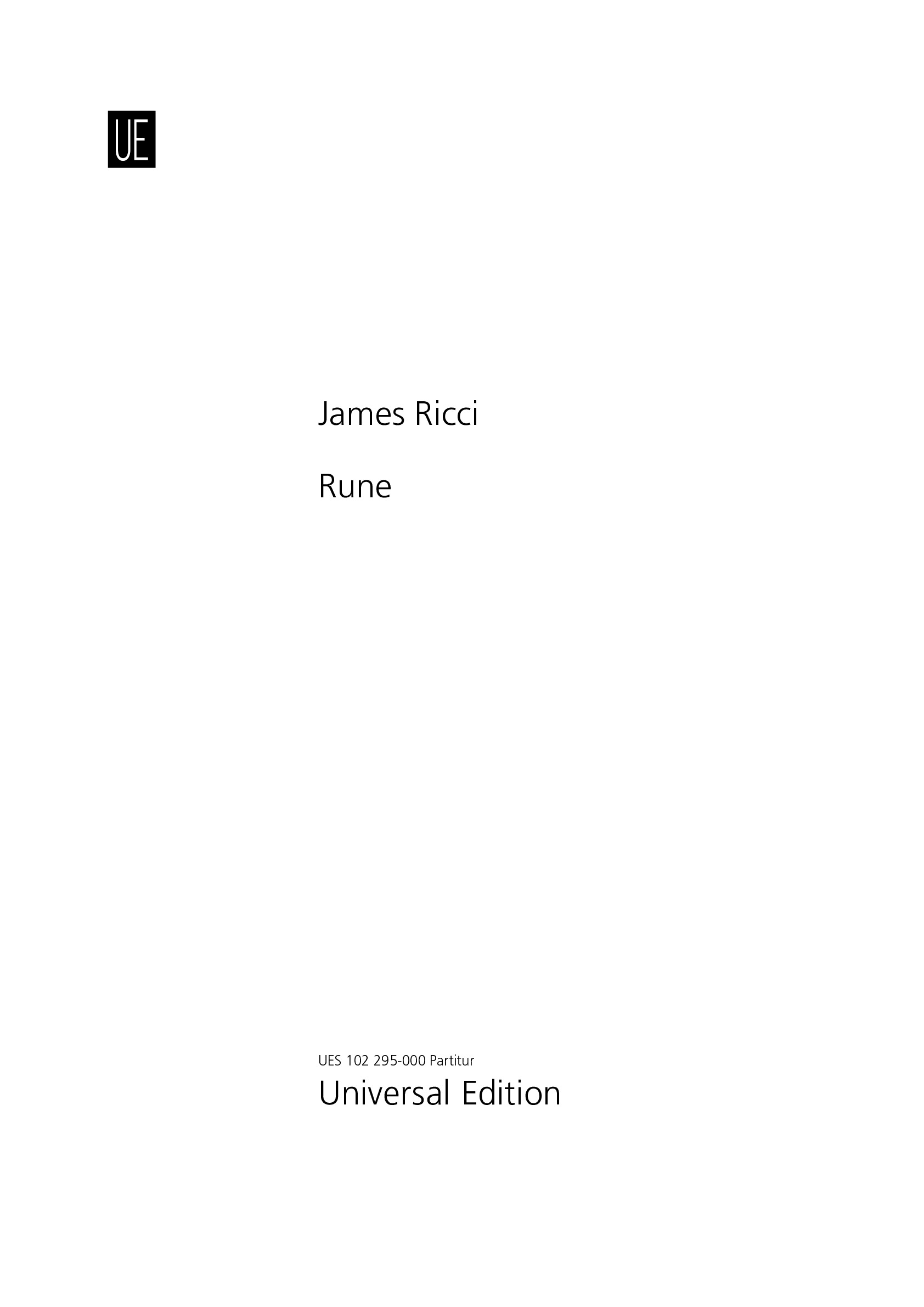

James Ricci
Rune
Short instrumentation: 3 2 3 3 - 4 3 3 1, timp, perc, hp, cel, str
Duration: 7'
Instrumentation details:
1st flute
2nd flute
3rd flute (+picc)
1st oboe
2nd oboe
1st clarinet in Bb
bass clarinet
2nd clarinet in Bb
1st bassoon
contrabassoon
2nd bassoon
1st horn in F
2nd horn in F
3rd horn in F
4th horn in F
1st trumpet in C
2nd trumpet in C
3rd trumpet in C
1st tenor trombone
bass trombone
2nd tenor trombone
tuba
timpani
percussion
celesta
harp
violin (16 players)
violin II (14 players)
viola (12 players)
violoncello (10 players)
double bass (8 players)
Rune
Sample pages
Audio preview
Video
Work introduction
Rune (2020) for orchestra
The title of this work derives from the mysterious markings I observed on ancient Rune Stones in Denmark that date back to the beginning of human civilization. It seemed to me that the meaning of musical ideas can also be preserved over time and appreciated by listeners even if they don’t fully comprehend the technical or syntactic process that went into the genesis of the work. Rune is seven minutes in duration and expresses a broad range of ideas, feelings, and musical statements - all of which occurred to me during the period of pandemic isolation. Rune was completed on September 9th, 2020. It has been recorded by Filharmonie Brno (conducted by Mikel Toms) for Ablaze Records Orchestral Masters Vol. 9 ar-00066.
-James Ricci
What is necessary to perform this work?
Rehearsal Notes for the Conductor:
Rune for Orchestra (2020)
The title derives from the mysterious markings I observed on ancient Rune Stones in Denmark – that date back to the beginning of human civilization. It seemed to me that the meaning of musical ideas can also be preserved over time and appreciated by listeners even if they don’t fully comprehend the technical or syntactic process that went into the genesis of the work.
I intended Rune to be a direct and light composition. It should move along at a moderate pace and have a discernable ictus throughout most of its sections.
Three Timpani are required, tuned to C2, F2, and G2. Percussionist uses: Tam-tam, Cymbals, and Claves.
Rune is approximately 7 minutes in duration.
Mm 1-6 Introductory music, presentation of materials. No particular instrument should stand out.
Mm 7-23 (rehearsal A) is an exposition of music played mostly by the Strings with punctuation and support by the Winds.
Mm 24-38 (rehearsal B) begins with a one-bar autonomous figure in the Strings. A section with Winds supported by Timpani and Harp follows. The ascending quarter notes in Mm 36-38 of the Winds refer back to the opening of the work. The String tremolo’s in m32 are unmeasured and fast.
Mm 39-47 (rehearsal C) returns focus to the Strings and has an off-beat dance-like rhythmic feel supported by a pizzicato syncopated bass line (doubled by the Harp). (Harp doubling could be reduced or eliminated if needed).
Mm 48-61 (rehearsal D) starts with a 2-bar Winds and Harp antecedent phrase (Mm48-49) followed by a 2-bar consequent phrase in the Strings (Mm 50-51). Mm 52-61 presents an extended Clarinet 1 solo which is supported by Strings and Harp. It builds into a minor climax in m61.
Mm 62-72 (one bar before rehearsal E) starts with a 2-bar phase in the Winds (Mm 62-63) followed by imitation of the same idea in the Brass (Mm 63-64). Intonation between the instrumental groups will be important here. The two-note figure in the Violins (doubled by Celeste and Harp) in Mm 67-68 is thematic and repeated in Mm 69-70. M72 both ends the prior phrase and overlaps with the beginning of the new phrase into rehearsal F.
Mm 73-88 (rehearsal F) is focused on the Strings and divided in two phrases (m73 to m80 and m81 to 88). The first phrase is supported a tag by Winds in 81, and the second phrase is picked up in the same measure by the Cellos.
The Bass Clarinet half-note figure that begins in m72 and runs through m80 is a background element and should blend in with the strings rather than be heard in the foreground. The Winds take over from m85 to m88, although m85 overlaps both instrumental groups. Measure 88 adds a Celeste riff to the Wind sequence which is resolved musically in the first measure of the next section.
Mm 89-96 (rehearsal G) offers several Wind solos (Clar. 1, Ob. 1, Fl. 1, Picc.) supported by arpeggiated chords in the Strings and Harp. French Horns enter for the first time in m94. The Harp adds a tag to the section in m96. This section has a Recitative quality. After the chords are conducted in time, the soloists can be a little free about their metric pulse. In practice, the first half note in the Harp and Strings of m90 and m92 may have a short fermata on top of each while the conductor waits for the soloist to end their phrase. This is too subtle to notate, but can be implied by the flow of the music.
Mm 97-103 (rehearsal H) features the French Horns. Horns 1, 2 alternate playing a motivic figure with Horns 3, 4. This might require some extra time in rehearsal to perfect. They are supported by a soft, rigid accompanying pattern in the Flutes and Celeste.
Mm 104-112 (rehearsal I) has two elements in the four measures from 104 to 107:
1) A long descending 16th note continuous line in the Winds and,
2) A descending sequence of sonorous half-note chords in the Strings.
The 16th notes should sound as homogenous as possible across instruments – blending with uniformity from one instrument to the next. This section may require extra rehearsal. The Strings provide a secondary support harmony, but require divisi parts. It should be played in tune. Mm108-112 develops the material in spurts with Clarinets and Bassoons.
Mm 113-128 (rehearsal J) starts with all four Horns playing a chorale-like progression for three measures. This phrase is cadential. Note the ritardando to quarter = 60 through the first two beats of m115. The second half of m115 is back to the baseline tempo of quarter = 84. This Horn choir closes off the body of the work.
What follows from the second half of m115 to the end of the work functions as a Coda. Mm 118 to 128 should be metronomic, regular, and static. The Eb (D#) pedal in the Harp lasts for 10 measures while various figures and repeated patterns occur above it. There is no primary music element here. All parts contribute to an overall texture; however, the Tuba has a mini-solo in Mm124-125 and Mm127-128. Mm 128 and 129 may need extra rehearsal to make sure that the combined 16th note rhythm is in the Winds and Brass is well-articulated.
Mm 129-136 (rehearsal K) is a continuation of the Coda. It begins with three measures of contrapuntal music for the Strings. The Harp arpeggio in m132 is followed by various patterns in the Winds that have a Scherzando character. Ob. 1 imitates Fl. 1 in m136.
Mm 137-148 (rehearsal L) Timpani, Percussion, and Celeste return in this section. The Clarinets in m137-138 should use flutter-tongue and sound raw. The Strings play soft and tranquillo. The Percussionist plays a short figure on the Claves, but this could be substituted by any wood-sounding instrument (including Temple or Wood Block).
Once again, this entire section has no primary voice and consists of a composite (harmonically static) texture of various elements. The combined triplet figure for Flutes 1 and 2 in m141 and m143 may need a little extra rehearsal time to sharpen their rhythmic effect. The final gesture played by the Celeste in m147 and 148 should be soft and gentle.

